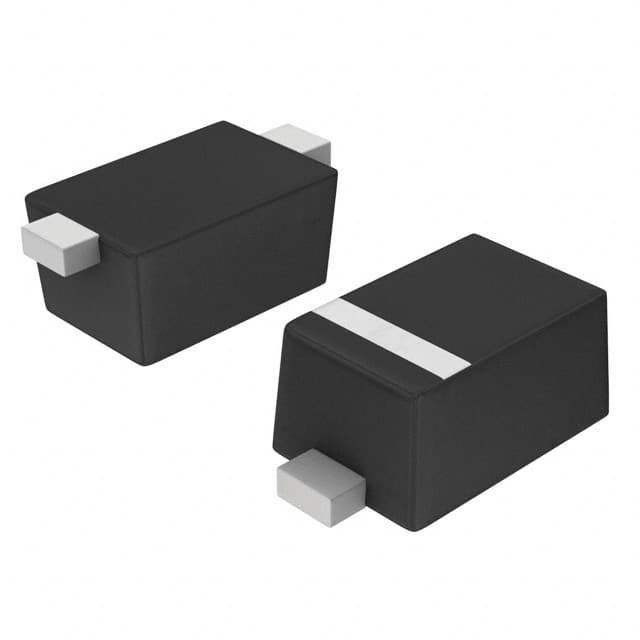SZESD5Z3.3T1G
Product Overview
Category
The SZESD5Z3.3T1G belongs to the category of semiconductor devices, specifically within the realm of voltage suppressors or transient voltage suppressor diodes (TVS diodes).
Use
It is primarily used for protecting sensitive electronic components from voltage transients and spikes.
Characteristics
- Low clamping voltage
- Fast response time
- High surge current capability
Package
The SZESD5Z3.3T1G is typically available in a surface-mount package, such as SOD-523, with a compact form factor suitable for modern electronic designs.
Essence
The essence of this product lies in its ability to divert excessive voltage away from sensitive components, thereby safeguarding them from damage.
Packaging/Quantity
These diodes are commonly supplied in reels or tape and reel packaging, with quantities varying based on manufacturer specifications.
Specifications
- Voltage Rating: 3.3V
- Peak Pulse Power: 200W
- Operating Temperature Range: -55°C to 150°C
- Breakdown Voltage: 3.3V
- Reverse Standoff Voltage: 2.8V
Detailed Pin Configuration
The SZESD5Z3.3T1G typically features two pins, with the anode and cathode connections clearly marked for easy integration into circuit designs.
Functional Features
- Transient Voltage Suppression: Effectively clamps transient voltages to protect downstream components.
- Fast Response Time: Rapid reaction to voltage spikes ensures minimal impact on the protected circuitry.
- Low Clamping Voltage: Provides effective protection without imposing excessive voltage drop during normal operation.
Advantages and Disadvantages
Advantages
- Effective protection against voltage transients
- Compact form factor for space-constrained applications
- High surge current capability
Disadvantages
- Limited to specific voltage ratings
- May require additional components for comprehensive overvoltage protection
Working Principles
When a transient voltage spike occurs, the SZESD5Z3.3T1G diode rapidly conducts, diverting the excess energy away from the sensitive components. This action effectively limits the voltage across the protected circuit, preventing damage.
Detailed Application Field Plans
The SZESD5Z3.3T1G finds extensive use in various electronic systems, including: - Consumer electronics - Automotive electronics - Industrial control systems - Telecommunications equipment
Detailed and Complete Alternative Models
- SZESD5Z5.0T1G: 5.0V breakdown voltage TVS diode
- SZESD5Z12T1G: 12V breakdown voltage TVS diode
- SZESD5Z24T1G: 24V breakdown voltage TVS diode
In conclusion, the SZESD5Z3.3T1G serves as a crucial component in protecting electronic circuits from voltage transients, offering a balance of performance and compactness. Its application spans across diverse industries, ensuring the integrity of sensitive electronics in the face of unpredictable voltage fluctuations.
Word Count: 443
قم بإدراج 10 أسئلة وإجابات شائعة تتعلق بتطبيق SZESD5Z3.3T1G في الحلول التقنية
What is SZESD5Z3.3T1G used for in technical solutions?
- SZESD5Z3.3T1G is a low capacitance ESD protection diode designed to protect sensitive electronics from electrostatic discharge (ESD) and other transient voltage events.
How does SZESD5Z3.3T1G protect electronic devices?
- SZESD5Z3.3T1G provides a low impedance path to divert transient currents away from sensitive components, preventing damage from ESD and other voltage spikes.
In what applications can SZESD5Z3.3T1G be used?
- SZESD5Z3.3T1G is commonly used in applications such as USB ports, HDMI interfaces, Ethernet ports, and other high-speed data lines to protect against ESD events.
What is the maximum voltage rating of SZESD5Z3.3T1G?
- The maximum voltage rating of SZESD5Z3.3T1G is 3.3V, making it suitable for protecting low-voltage electronic circuits.
Does SZESD5Z3.3T1G affect signal integrity in high-speed data lines?
- No, SZESD5Z3.3T1G has low capacitance and high bandwidth, ensuring minimal impact on signal integrity in high-speed data transmission.
Can SZESD5Z3.3T1G be used in automotive applications?
- Yes, SZESD5Z3.3T1G is suitable for automotive electronics where protection against ESD and transient voltage events is critical.
What is the operating temperature range of SZESD5Z3.3T1G?
- SZESD5Z3.3T1G has an operating temperature range of -40°C to 125°C, allowing it to be used in a wide range of environmental conditions.
Is SZESD5Z3.3T1G RoHS compliant?
- Yes, SZESD5Z3.3T1G is compliant with the Restriction of Hazardous Substances (RoHS) directive, making it suitable for use in environmentally conscious designs.
How does SZESD5Z3.3T1G compare to other ESD protection devices?
- SZESD5Z3.3T1G offers low clamping voltage and fast response time, providing effective protection compared to other ESD protection devices.
Are there any application notes or design guidelines available for using SZESD5Z3.3T1G in technical solutions?
- Yes, detailed application notes and design guidelines are available from the manufacturer to assist engineers in implementing SZESD5Z3.3T1G effectively in their designs.


